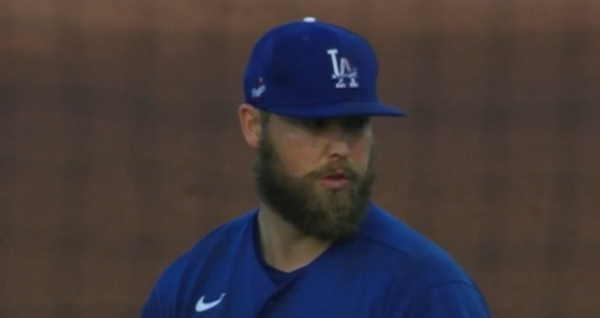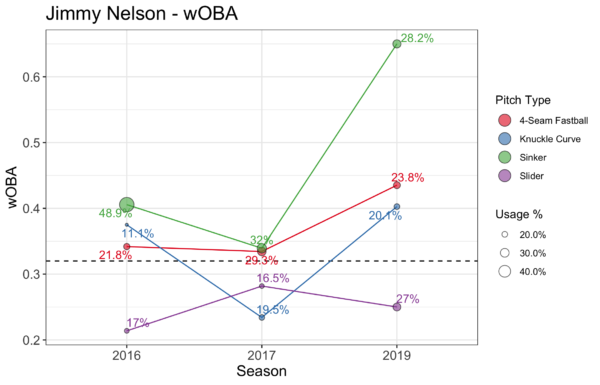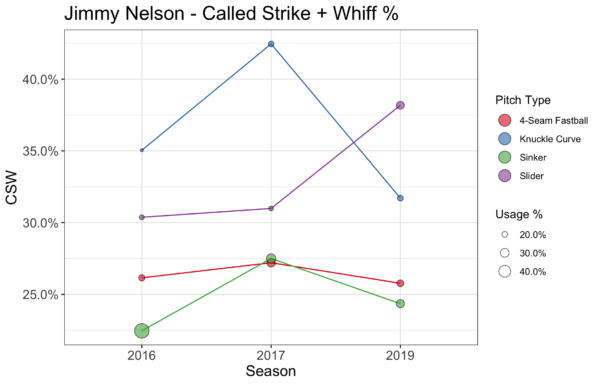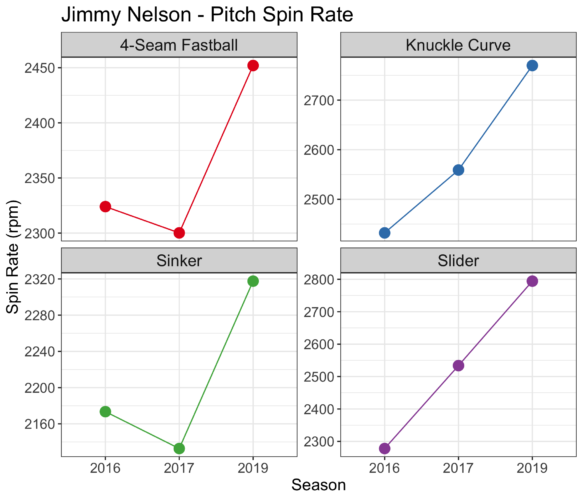
In January 2020, the Dodgers signed former Brewers starting pitcher Jimmy Nelson to a low-risk contract, hoping to seize on his considerable upside. Nelson was the ace of the Brewers pitching staff in 2017 before suffering a shoulder injury sliding into first, ending his season, and putting his entire professional career in limbo. He didn’t throw a single professional pitch in 2018 and was only on the mound for 22 major league innings in 2019 before being shut down with a nagging elbow issue. The Brewers released Nelson on December 2nd that year and the Dodgers signed him just a month later.
The Dodgers have a long track record of success with pitching reclamation projects, so the organizational fit was easy to see. Unfortunately, Nelson’s hopes of joining the 2020 roster were shot when it was announced he would need to undergo back surgery before throwing a single pitch last season. The Dodgers declined their option to retain Nelson for the 2021 season, but resigned him to a minor league deal, again taking a flyer, hoping for a healthy year of performance. He was offered a spot with major league camp as a non-roster spring training invitee this year, and has dazzled. His stellar performances have likely thrusted him onto the opening day roster.
Over 7 innings, Nelson struck out 9, allowing just 4 hits, 1 walk and 0 earned runs. But it’s only spring training. Top-line stats like that aren’t very predictive. What matters is your command and your stuff, and he’s showcased both in spades, as you can see for yourself here.
Jimmy Nelson, Breaking Ball Filth. 😷 pic.twitter.com/ByFe32BstV
— Rob Friedman (@PitchingNinja) March 10, 2021
Although Nelson missed all of 2018 and put up disappointing numbers in 2019 over a disappointing number of innings, I’m not convinced he ever really lost it. In fact, his peripherals and pitch tracking data suggest that throughout his injury-addled 2019, he was very close to reclaiming if not exceeding the greatness of his 2017.
——
Let’s start with the ugly: wOBA allowed by Nelson between 2016, 2017 and (a shortened) 2019. If you’re not familiar with wOBA, here’s a quick primer. It’s similar to OPS in that it is a measure of offensive production that weights more heavily for different extra base hits than it does for singles and walks. For a pitcher, a higher wOBA against is a bad thing. You want to limit hitters to a low wOBA (just like you would want to limit hitters to a low OPS).
In the plot below, I’m visualizing the wOBA allowed by each of Nelson’s four major pitches. The dot sizes and the text indicate the usage % for each pitch in that season. The horizontal dashed line indicates the league average wOBA allowed. Anything below the dashed line is a pitch that was better-than-average for Nelson. It’s not hard to see how 2017 was such a banner year. He lived and died with his breaking stuff (the curve and the slider) which were both exceptional. Through limited innings, his slider continued to be a very good pitch for him in 2019, so it makes sense that he would increase it’s relative usage from 16.5% in 2017 to 27% in 2019. His other pitches took a beating, though. Nelson’s curveball, his best pitch from 2017, took a major step back, but his sinker was absolutely demolished.

How did this happen? It’s pretty simple, actually. Much like Blake Treinen back in 2019, Nelson was nursing an injured elbow all season! It’s hard to control where the ball goes when your elbow is nagging you. What happens when you can’t control the ball? It’s harder to target the strike zone with precision so you often throw balls. You find yourself falling behind in the count, leading to more walks. In an effort to avoid walks with reduced control, you start throwing meatballs that get blasted to the moon. Here is Nelson’s zone % (percent of pitches thrown in the strike zone) against his walk rate. Notice a relationship?

Why am I not worried? I’m not worried because by every indication, Jimmy Nelson is healthy this season. His pitching woes were largely due to control and command issues all stemming from a bad elbow. His “stuff” was not ever really in question.
——
Let’s explore a few encouraging stats. Below is a simple metric called CSW, which stands for “called strikes and whiff % rate”. It’s just the percentage of pitches that result in called strikes and whiffs. It’s a fairly good predictor of future performance. Anything above 30% is good but anything above 35% is excellent. Nelson’s slider and especially his curve racked up a lot of strikes in 2017. His curveball CSW% significantly dropped in 2019, but that originates from his injury and related command issues. A good curveball is a finesse pitch. Interestingly, the slider CSW% improved (consistent with the drop in wOBA against visualized above). He also threw the slider much more in 2019 than he did in 2017, so it appears he felt confident in this particular pitch, despite the nagging injury injury.

What about Nelson’s pitch movement? Below I’ve plotted the horizontal (x-axis) and vertical movement (y-axis) caused by spin alone (i.e. removing effect of gravity). The tiny dots are individual pitches while the big dots represent average movement. Nelson’s slider saw reduced vertical movement in 2019, but an additional 6 inches of horizontal moment! This likely explains the observed increase in CSW%. Nelson’s curve saw over 6″ of additional drop in 2019 (that’s a good thing), but was much less effective than it was in 2017, despite additional moment. This, again, is likely due to poor control. A sharp curveball that shows early to be well outsize the zone doesn’t trick professional hitters. The additional downward movement from Nelson’s curve it very encouraging, in any event. Without injury hampering his command, this should be an absolutely killer pitch.
Nelson’s sinker lost just a bit of its horizontal movement. That coupled with poor command is a recipe for disaster. Every sinker thrown low in the zone is much easier to barrel up. His four seamer lost nearly all of its horizontal movement and didn’t gain any vertical movement. I suspect this is due to a change in grip, and the orientation of the seams, not arm action. Not all four seam grips are the same! Whatever grip he used in 2016 and 2017, he should return to in 2021.

What is responsible for the additional movement in Nelson’s breaking stuff? It could be couple things, but my guess is a fairly dramatic increase in spin rate. Below I’ve plotted the average spin rate for each of Nelson’s four main pitches across seasons. Where did the additional spin came from? You be the judge of that one, folks. In any case, more spin can make for additional movement and it appears it did just that in 2019. If Nelson can maintain the observed increase in spin, we’re likely to see a lot of electric strikeouts. I mean, just rewatch the Pitching Ninja tweet I embedded above. It’s glorious.

My takeaway from all this is that a healthy Jimmy Nelson is primed for success. He never really lost his stuff and his stuff coupled with the return of pitch command is going to be very effective. Nelson’s breaking balls are, by far, his best pitches, so I hope he continues to use the slider and curve primarily, as he has in his spring training outings. Oh, and he really needs to drop the sinker entirely, or maybe relegate it to a 5% usage “show me” pitch, just to keep it in the hitter’s head.
Given the Dodgers existing proclivity for load management, Nelson’s injury history, and the battery of starters already slated for the rotation, it’s likely Roberts will use Nelson as a reliever primarily, if he makes the roster. I could see him take on a bulk relief role, but I could also see him assume a role in the back of the bullpen. It’s all up for grabs, frankly. He just needs to stay healthy.
 Dodgers Digest Los Angeles Dodgers Baseball Blog
Dodgers Digest Los Angeles Dodgers Baseball Blog